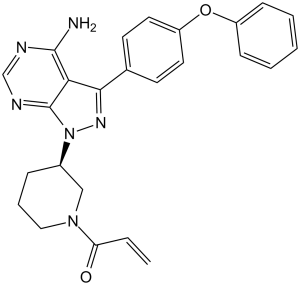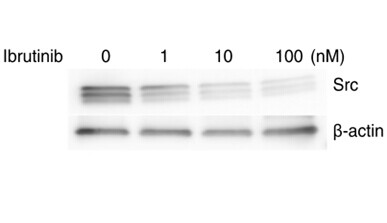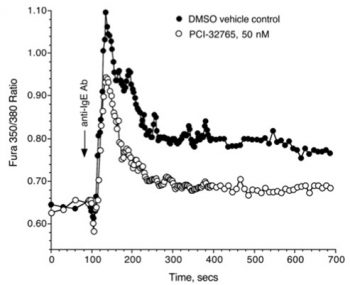This product is for research use only, not for human use. We do not sell to patients.

| Size | Price | Stock |
|---|---|---|
| 5g | $700 | In Stock |
| 10g | $1150 | In Stock |
| 20g | $1725 | In Stock |
Cat #: V0643 CAS #: 936563-96-1 Purity ≥ 98%
Description: Ibrutinib (formerly PCI32765; trade name Imbruvica), an approved anticancer drug, is a covalent/irreversible and orally bioavailable Brutons tyrosine kinase (Btk) inhibitor with potential anti-cancer activity. It inhibits BTK with an IC50 of 0.5 nM in cell-free assays, and exhibits modest potency against other kinases such as Bmx, CSK, FGR, BRK, HCK, less potent to EGFR, Yes, ErbB2, JAK3, etc. on November 13th 2013, Ibrutinib was approved by the US FDA for the treatment of mantle cell lymphoma.
Publications Citing InvivoChem Products
Product Promise

- Physicochemical and Storage Information
- Protocol
- Related Biological Data
- Stock Solution Preparation
- Quality Control Documentation
| Molecular Weight (MW) | 440.5 |
|---|---|
| Molecular Formula | C25H24N6O2 |
| CAS No. | 936563-96-1 |
| Storage | -20℃ for 3 years in powder formrr |
| -80℃ for 2 years in solvent | |
| Solubility In Vitro | DMSO: 88 mg/mL (199.8 mM)rr |
| Water: <1 mg/mLrr | |
| Ethanol: <1 mg/mL | |
| Solubility In Vivo | 2% DMSO+Castor oil: 10 mg/mL |
| SMILES Code | C=CC(N1C[C@H](N2N=C(C3=CC=C(OC4=CC=CC=C4)C=C3)C5=C(N)N=CN=C52)CCC1)=O |
| Synonyms | PCI-32765; PCI-32765, Ibrutinib, PCI 32765; |
| Protocol | In Vitro | In vitro activity: Ibrutinib shows the potent and irreversible inhibitory effect and selectivity for Btk enzymatic activity. In BCR pathway-activated DOHH2 cell line, Ibrutinib inhibits autophosphorylation of Btk, phosphorylation of Btk's physiological substrate PLCγ, and phosphorylation of further downstream kinase, ERK with IC50 of 11 nM, 29 nM and 13 nM, respectively. Ibrutinib exhibits a significant dose-dependent and time-dependent induction of cytotoxicity in chronic lymphocytic leukemia (CLL) cells. In addition, Ibrutinib induces cell death depending on caspase pathway activation and antagonizes the ability of CLL cells to proliferate after TLR signaling. A recent study shows that Ibrutinib inhibits BCR-activated primary B cell proliferation with IC50 of 8 nM and results in inhibition of TNFα, IL-1β and IL-6 production in primary monocytes with IC50 of 2.6 nM, 0.5 nM and 3.9 nM, respectively. Kinase Assay: In vitro kinase IC50 values are measured using 33P filtration binding assay after 1 hour incubation of kinase, 33P-ATP, Ibrutinib, and substrate [0.2 mg/mL poly(EY)(4:1]. Assays are performed at Reaction Biology. Cell Assay: MTT (3'[4,5-dimethylthiazol-2-yl]-2,5-diphenyl-tetrazolium bromide) assays are performed to determine cytotoxicity. Briefly, cells (CLL B cells or healthy volunteer T cells or NK cells) are incubated for 48 hours with different concentrations of Ibrutinib, or vehicle control. MTT reagent is then added, and plates are incubated for an additional 20 hours before washing with protamine sulfate in phosphate-buffered saline. Dimethyl sulfoxide is added, and absorbance is measured by spectrophotometry at 540 nm in a Labsystems plate reader. Cell viability is also measured at various time points with the use of annexin/PI flow cytometry. Data are analyzed with Expo-ADC32 software package. Results are expressed as the percentage of total positive cells over untreated control. Experiments examining caspase-dependent apoptosis includes the addition of 100μM Z-VAD. |
|---|---|---|
| In Vivo | MRL-Fas(lpr) lupus model and collagen-induced arthritis model. | |
| Animal model | Male 5-week-old BALB-nu/nu with HPAC cells |
| Solvent volume to be added | Mass (the weight of a compound) | |||
|---|---|---|---|---|
| Mother liquor concentration | 1mg | 5mg | 10mg | 20mg |
| 1mM | 2.2701 mL | 11.3507 mL | 22.7015 mL | 45.4030 mL |
| 5mM | 0.4540 mL | 2.2701 mL | 4.5403 mL | 9.0806 mL |
| 10mM | 0.2270 mL | 1.1351 mL | 2.2701 mL | 4.5403 mL |
| 20mM | 0.1135 mL | 0.5675 mL | 1.1351 mL | 2.2701 mL |
This equation is commonly abbreviated as: C1 V1 = C2 V2
- (1) Please be sure that the solution is clear before the addition of next solvent. Dissolution methods like vortex, ultrasound or warming and heat may be used to aid dissolving.
- (2) Be sure to add the solvent(s) in order.







































